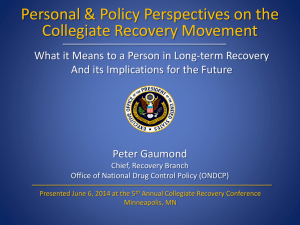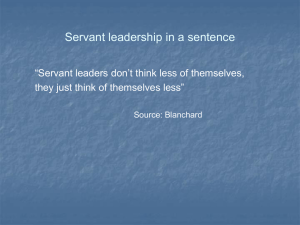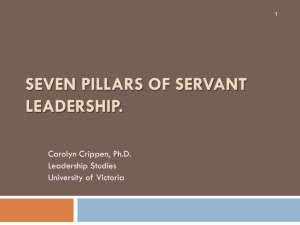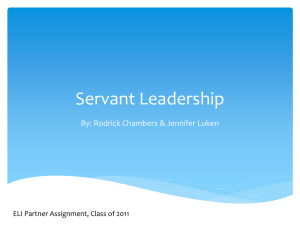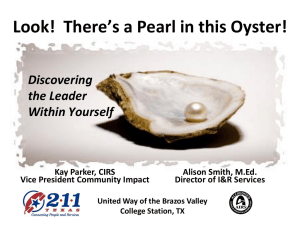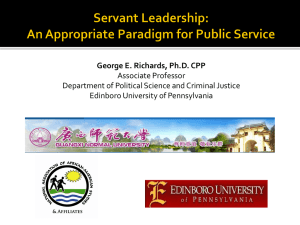Leading in Higher Education
advertisement
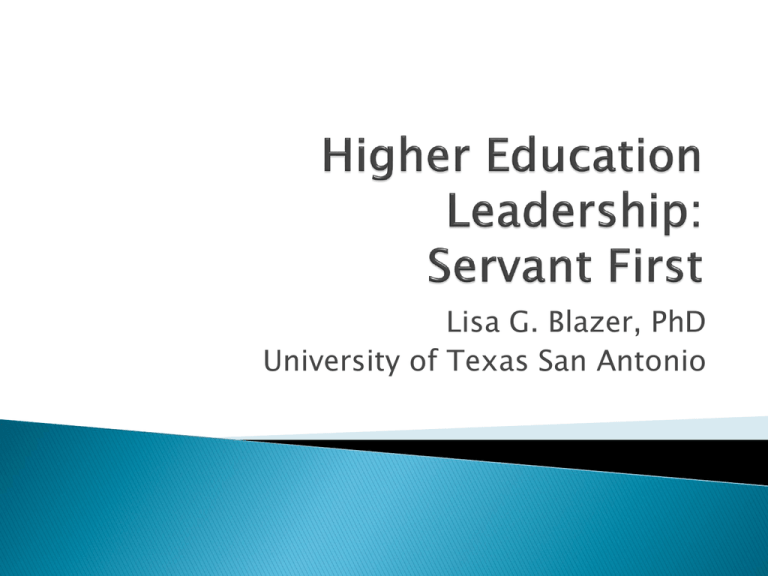
Lisa G. Blazer, PhD University of Texas San Antonio Changes ◦ ◦ ◦ ◦ ◦ ◦ ◦ Financial pressures Growth in technology Changing faculty roles Public scrutiny Changing demographics of employees and students Competing values across campus Rapid change New goals and fluctuating needs and purpose ◦ Increased emphasis on service and meeting needs of students ◦ Developing the whole student Counseling Technology Health Entertainment Career Development Accountability – 4 year graduation rates impacting federal and/or state funding levels Holistic Development of the student 1st Year Experience Service learning Multiculturalism and diversity Students needs are changing Student Affairs staff diversity Access and Opportunity Retention and Graduation Learning outcomes in and out of the classroom Partnerships with Academic Affairs Find Revenue Sources – fees for buildings, campus rec, health services, athletics Assessment, assessment, assessment “The first and most important choice a leader makes is the choice to serve, without which one’s capacity to lead is severely limited.” ◦ Robert K. Greenleaf, 1977 It’s not about power, it’s about authority Leadership is about contributing to hearts, minds, and spirits Taught music theory Taught how to play an instrument Takes skill to get a variety of different people, playing different instruments to play in harmony That’s the job of a leader – working towards a common goal – influencing people to work in harmony Seven Pillars of Servant Leadership (Sipes, & Frick, 2009) ◦ Person of Character ◦ Puts People First ◦ Skilled Communicator ◦ Compassionate Collaborator ◦ Foresight ◦ Systems Thinker ◦ Leads with Moral Authority Makes insightful, ethical and principle-centered decisions, Maintains integrity, Demonstrates humility, Serves a higher purpose Leading in Higher Education – you are serving students first so humility is key to being an effective leader in higher education, we are called to what we do in higher education Leading Financial Decisions – integrity and ethical practices should be at the core of every decision you make because you are a steward of resources Helps others meet their highest priority and development needs, Displays a servant’s heart, Mentor minded, Shows care & concern Leading in Higher Education – Build relationships first, people need to see that you care so they will trust you across the whole campus Leading Financial Decisions – You have to take care of the people who work for you and with you. Regulations, rules and priorities will shift so training and development are key to successfully managing large sums of money and large numbers of students Listens earnestly and speaks effectively, Demonstrates empathy, Invites feedback, Communicates persuasively Leading in Higher Education – Listening to the needs of those around you and to administrators will serve you well in higher education, don’t be afraid to hear critique, take it, learn from it and move forward, don’t be afraid to give critique when needed Leading Financial Decisions – While we operate with regulations in most financial decisions, we need to listen to those around us and then communicate what needs to happen based on feedback and concerns expressed Strengthens relationships, Supports diversity, Creates a sense of belonging, Expresses appreciation, Builds teams, Negotiates conflict Leading in Higher Education – diversity of thought is there, you have to embrace it or you won’t survive as a leader in higher education, conflict is inevitable – it’s how you respond that is important Leading Financial Decisions – Financial decisions are not made in a vacuum, there’s too much at stake, listen to those around you and don’t be afraid to work through conflict, especially if you are the one responsible for money to students Imagines possibilities, anticipates the future, proceeds with clarity of purpose, Visionary, Displays creativity, Exercises sound judgment Leading in Higher Education – We are moving a the speed of light so you have to think ahead and be creative with the resources you have, making solid decisions about your operations or the impact it will have on the university’s future is necessary Leading Financial Decisions – there’s much at stake for students and the university, so you need to know what’s coming around the bend and think about new ways of projecting revenue and expenditures Thinks and acts strategically, Leads change effectively, Balances the whole with the sum of its parts, Comfortable with complexity, Demonstrates adaptability, Considers the Greater good Leading in Higher Education – change is inevitable so learn how to lead it. Higher education is complex and it’s important to not operate in your own silo Leading Financial Decisions – funding sources will change through enrollment, institutional or state funding cuts, it’s a balancing act Worthy of respect, Inspires trust and confidence, Establishes quality standards for performance, Accepts and delegates responsibility, Shares power and control, Creates a culture of accountability Leading in Higher Education – if you build relationships and make quality decisions, you will gain respect and trust from those around you. Assess what you are doing and base your decisions on data you collect, it’s not about you so don’t try to control everything, staff need to be knowledgeable so train them and then set specific expectations Leading Financial Decisions – tax payers are the recipients so there has to be accountability for spending, that includes dollars given to students, salaries paid to staff for the work they do and any other expense associated with serving students Leadership involves influencing people to contribute their hearts, minds, spirits, creativity and excellence and give their all “Leadership…is a serious meddling in the lives of others.” Max Dupree Greenleaf, R. (1977, 2002, 2007). Servant leadership: a journey into the nature of legitimate power and greatness. New York/Mahwah, NJ: Paulist Press Sipes, J. & Grick, D. (2009). Seven pillars of servant leadership: practicing the wisdom of leading by serving. New York/Mahwah, NJ: Paulist Press Clifton, D. & Nelson, P. Soar with your strengths. (1992). New York: Dell Publishing Keeling, P., Wall, A., Underhile, R, Dungy, G. (2008) Assessment Reconsidered: Institutional effectiveness for student success. NASPAStudent Affairs Administrators in Higher Education and Keeling & Associates, LLC McClellan, G. & Stringer, J. (2009) The handbook of student affairs administration. San Francisco: John Wiley & Sons, Inc. NASFAA Authors (2012). You’re the Director: A guide to leadership in student financial aid. Washington, DC: NASFAA


